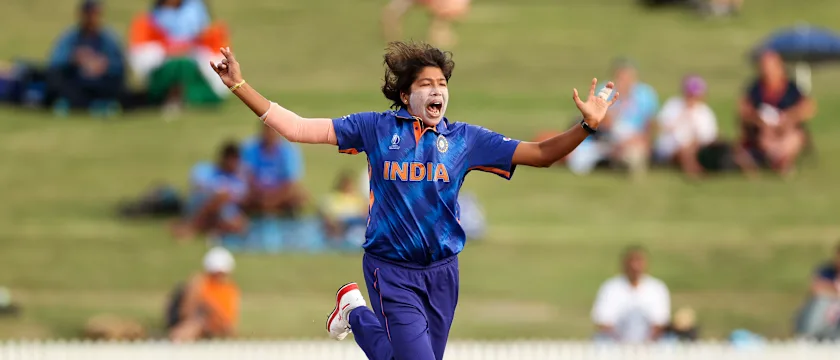Day 9 Talking Points: Jhulan Goswami breaks World Cup record, batters fire India to win

M10 Match Highlights: West Indies v India | CWC22
Breaking the record for most Women's Cricket World Cup matches as captain, Mithali Raj continues to leave no stone unturned with the side's batting order, moving herself up to No.3 in favour of Deepti Sharma.
While the shuffle may not have delivered the desired result, making just 20 runs between them in the new roles, the opening pair of Smirti Mandhana and Yastika Bhatia showed glimpses of a world-class partnership.
Preferred to Shafali Verma once more for more measure at the top, Bhatia showed her aggressive side with a host of pull shots and cover drives, capitalising on the mix of bowling dished up by the West Indies pace attack.
Bhatia departed for a quick-fire 31, though Harmanpreet Kaur, a luxury at No.5, made an immediate impact with Mandhana.
Playing a supporting role after Bhatia's onslaught, Mandhana's manipulation of the field was the catalyst of India's middle-over acceleration, mixing ground shots with aerial aggression.
Highlights: Smriti Mandhana's outstanding century
Lifting her strike rate to play the key role, Mandhana's control helped Harmanpreet move into her work, in what was a strong counter-attack in response to a prosperous West Indies stretch.
The pair went on to compile 184 for the fourth wicket – the highest partnership in Women's Cricket World Cup history for India.
Both making outstanding hundreds individually, their partnership set up a late-over Indian flurry, as the women in blue pushed on to make the most of the strong base.
While India raced out of the blocks by jumping on the short-pitched bowling, the West Indies looked to have pulled things back, taking three wickets in 7.2-over stretch.
Stafanie Taylor's chargers were unable to keep the foot down in drying up the runs though even at 78/3, as Mandhana and Harmanpreet set about their work.
M10 Powerplay Highlights: West Indies v India | CWC22
Bereft of ideas, Taylor's side failed to back up their bowlers in a fielding malaise, and the complacency crept into the bowling, with four no balls and a spate of wides given away.
Taylor tried seven bowling options as well as herself in a desperate bid to stem the flow, though the work of their opponents and the flat fielding effort only made things more difficult.
Aaliyah Alleyne dropped a tough chance to dismiss Mandhana in the nineties, and the side leaked valuable runs in the final ten overs. From 233/3 at the end of the 40th over, India leapt to 317/8 seemingly in a canter.
Gifted a free hit by Deandra Dottin, Harmanpreet swept over backward square-leg for six to add salt into the wound, before a Chedean Nation misfield compounded things further.
Flat in their fielding effort, the West Indies were also slow in terms of their over rate, forced to rush through to the end of the innings with spin opted for at the death.
Jhulan Goswami added yet another feather to her crowded cap. With the wicket of Anisa Mohammed, she became the leading wicket-taker in ICC Women's Cricket World Cup history, surpassing late Lyn Fullston at 39 wickets.
Wicket - Anisa Mohammed - West Indies v India
A veteran of the game and pioneer of fast-bowling back home in India, Goswami made her World Cup debut way back in 2005 and has been the backbone of her team's bowling attack ever since. She has been a part of the team that went to finals twice, first in 2005 and then in 2017.
Goswami came into the tournament as the joint third-highest wicket-taker with 36 wickets, tied with former England star Clare Taylor. She picked up two wickets in the opening game against Pakistan and a wicket each against New Zealand and West Indies to become the highest wicket-taker of the tournament.
At 39 years of age, this could be Goswami's last World Cup and her teammates would want to give her a farewell fitting of the legend.
